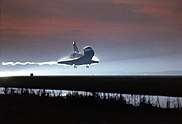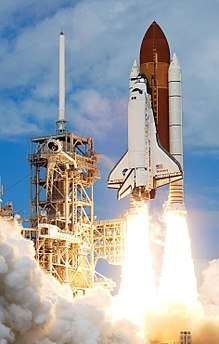Criticism of the Space Shuttle program
Criticism of the Space Shuttle program stemmed from claims that NASA's Shuttle program failed to achieve its promised cost and utility goals, as well as design, cost, management, and safety issues.[1] Fundamentally, it failed in the goal of reducing the cost of space access. Space Shuttle incremental per-pound launch costs ultimately turned out to be considerably higher than those of expendable launchers.[2] By 2011, the incremental cost per flight of the Space Shuttle was estimated at $450 million,[3] or $18,000 per kilogram (approximately $8,000 per pound) to low Earth orbit (LEO). By comparison, the comparable Proton launch vehicle is said to cost as little as $110 million,[4] or around $5,000/kg (approximately $2,300 per pound) to LEO, despite not being reusable.
When all design and maintenance costs are taken into account, the final cost of the Space Shuttle program, averaged over all missions and adjusted for inflation, was estimated to come out to $1.5 billion per launch, or $60,000/kg (approximately $27,000 per pound) to LEO.[5] This should be contrasted with the originally envisioned costs of $118 per pound of payload in 1972 dollars (approximately $635 per pound adjusting for inflation to 2011).[6]
It failed in the goal of achieving reliable access to space, partly due to multi-year interruptions in launches following Shuttle failures.[7] NASA budget pressures caused by the chronically high NASA Space Shuttle program costs have eliminated NASA manned space flight beyond low earth orbit since Apollo, and severely curtailed use of unmanned probes.[8] NASA's promotion of and reliance on the Shuttle slowed domestic commercial expendable launch vehicle (ELV) programs until after the 1986 Challenger disaster.[9]
Two out of the five spacecraft were destroyed in accidents, killing 14 astronauts, the largest loss of life in space.
Purpose of the system
"Space Transportation System" (NASA's formal name for the overall Shuttle program) was created to transport crewmembers and payloads into low Earth orbits.[10] It would afford the opportunity to conduct science experiments on board the shuttle to be used to study the effects of space flight on humans, animals and plants. Other experiments would study how things can be manufactured in space. The shuttle would also enable astronauts to launch satellites from the shuttle and even repair satellites already out in space.[11] The Shuttle was also intended for research into the human response to zero-g.[12]
The Shuttle was originally billed as a space vehicle that would be able to launch once a week and give low launch costs through amortization. Development costs were expected to be recouped through frequent access to space. These claims were made in an effort to obtain budgetary funding from the United States Congress.[13] Beginning in 1981, the space shuttle began to be used for space travel. However, by the mid-1980s the concept of flying that many shuttle missions proved unrealistic and scheduled launch expectations were reduced 50%.[14] Following the Challenger accident in 1986, missions were halted pending safety review. This hiatus became lengthy and ultimately lasted almost three years as arguments over funding and the safety of the program continued. Eventually the military resumed the use of expendable launch vehicles instead.[12] Missions were put on hold again after the loss of Columbia in 2003. Overall, 135 missions were launched during the 30 years after the first orbital flight of Columbia, averaging approximately one every 3 months.
Costs
Some reasons for the higher-than-expected operational costs were:
- The final design differed from the original concept, causing, among other things, the shuttle orbiter to be almost 20% over its specified weight – resulting in it being unable to boost the US Air Force's payloads into polar orbits.[15]
- Maintenance of the thermal protection tiles was a very labor-intensive and costly process, with some 35,000 tiles needing to be inspected individually and with each tile specifically manufactured for one specific slot on the shuttle.[16]
- The RS-25 engines were highly complex and maintenance-intensive, necessitating removal and extensive inspection after each flight. Before the "Block II" engines, the turbopumps (a primary engine component) had to be removed, disassembled, and totally overhauled after each flight.
- The toxic propellants used for the OMS/RCS thrusters required special handling, during which time no other activities could be performed in areas sharing the same ventilation system. This increased turn-around time.
- The launch rate was significantly lower than initially expected. While not reducing absolute operating costs, more launches per year gives a lower cost per launch. Some early hypothetical studies examined 55 launches per year (see above), but the maximum possible launch rate was limited to 24 per year based on manufacturing capacity of the Michoud facility that constructs the external tank. Early in shuttle development, the expected launch rate was about 12 per year.[17] Launch rates reached a peak of 9 per year in 1985 but averaged 4.5 for the entire program.
- When the decision was made on the main shuttle contractors in 1972, work was spread among companies to make the program more attractive to Congress, such as the contract for the Solid Rocket Boosters to Morton Thiokol in Utah. Over the course of the program, this raised operational costs, though the consolidation of the US aerospace industry in the 1990s meant the majority of the Shuttle was now with one company: the United Space Alliance, a joint venture of Boeing and Lockheed Martin.
Cultural issues and problems
For a successful technology, reality must take precedence over public relations, for nature cannot be fooled.
Some researchers have criticized a pervasive shift in NASA culture away from safety in order to ensure that launches took place in a timely fashion, sometimes called "go fever". Allegedly, NASA upper-level management embraced this decreased safety focus in the 1980s while some engineers remained wary. According to sociologist Diane Vaughan, the aggressive launch schedules arose in the Reagan years as an attempt to rehabilitate America's post-Vietnam prestige.[18]
The physicist Richard Feynman, who was appointed to the official inquiry on the Challenger disaster, estimated the risk to be "on the order of a percent" in his report, adding, "Official management, on the other hand, claims to believe the probability of failure is a thousand times less. One reason for this may be an attempt to assure the government of NASA perfection and success in order to ensure the supply of funds. The other may be that they sincerely believed it to be true, demonstrating an almost incredible lack of communication between themselves and their working engineers."[19]
Despite Feynman's warnings, and despite the fact that Vaughan served on safety boards and committees at NASA, the subsequent press coverage has found some evidence that NASA's relative disregard for safety might persist to this day. For example, NASA discounted the risk from small foam chunk breakage at launch and assumed that the lack of damage from prior foam collisions suggested the future risk was low.
Shuttle operations
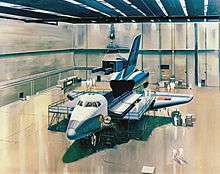
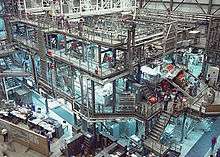
The Shuttle was originally conceived to operate somewhat like an airliner. After landing, the orbiter would be checked out and start being mated to the External Tank and Solid Rocket Boosters, and be ready for launch in as little as two weeks. In actual service, this turnaround process usually took months; Atlantis set the pre-Challenger record by launching twice within 54 days, while Columbia set the post-Challenger record of 88 days. The Shuttle program's goal of returning its crew to Earth safely conflicted with the goal of a rapid and inexpensive payload launch. Furthermore, because in many cases there were no survivable abort modes, many pieces of hardware had to function perfectly and so required careful inspection before each flight. The result was high labor cost, with around 25,000 workers in Shuttle operations and labor costs of about $1 billion per year.[6]
Some shuttle features initially presented as important to Space Station support have proved superfluous:
- As the Russians demonstrated, capsules and uncrewed supply rockets are sufficient to supply a space station.
- NASA's initial policy of using the Shuttle to launch all crewless payloads declined in practice, and eventually was discontinued. Expendable launch vehicles (ELVs) proved much cheaper and more flexible.
- Following the Challenger disaster, use of the Shuttle to carry the powerful liquid fueled Centaur upper stages planned for interplanetary probes was ruled out for Shuttle safety reasons.[20][21]
- The Shuttle's history of unexpected delays also made it liable to miss narrow launch windows.
- Advances in technology have made probes smaller and lighter. As a result, many robotic probes and communications satellites can now use expendable launch vehicles, such as the Delta and Atlas V, which are less expensive and perceived to be more reliable than the Shuttle.
Accidents
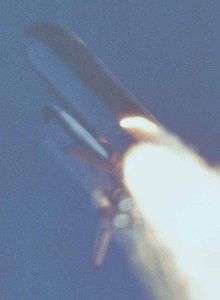
While the technical details of the Challenger and Columbia accidents are different, the organizational problems show similarities. Flight engineers' concerns about possible problems were not properly communicated to or understood by senior NASA managers. The vehicle gave ample warning beforehand of abnormal problems. A heavily layered, procedure-oriented bureaucratic structure inhibited necessary communication and action.
With Challenger, an O-ring that should not have eroded at all did erode on earlier shuttle launches. Yet managers felt that because it had previously eroded by no more than 30%, this was not a hazard as there was "a factor of three safety margin" (in reality, the part had failed, and there was no safety factor.) Morton-Thiokol designed and manufactured the SRBs, and during a pre-launch conference call with NASA, Roger Boisjoly, the Thiokol engineer most experienced with the O-rings, pleaded with management repeatedly to cancel or reschedule the launch. He raised concerns that the unusually low temperatures would stiffen the O-rings, preventing a complete seal during flexing of the rocket motor segments, which was exactly what happened on the fatal flight. However, Thiokol's senior managers, under pressure from NASA management, overruled him and allowed the launch to proceed. One week prior to the launch, Thiokol's contract to reprocess the solid rocket boosters was also due for review, and cancelling the flight was an action that Thiokol management wanted to avoid. Challenger's O-rings eroded completely through as predicted, resulting in the complete destruction of the spacecraft and the loss of all seven astronauts on board.
Columbia was destroyed because of damaged thermal protection from foam debris that broke off from the external tank during ascent. The foam had not been designed or expected to break off, but had been observed in the past to do so without incident. The original shuttle operational specification said the orbiter thermal protection tiles were not designed to withstand any debris hits at all. Over time NASA managers gradually accepted more tile damage, similar to how O-ring damage was accepted. The Columbia Accident Investigation Board called this tendency the "normalization of deviance" – a gradual acceptance of events outside the design tolerances of the craft simply because they had not been catastrophic to date.[22]
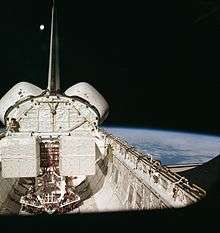
The subject of missing or damaged thermal tiles on the Shuttle fleet only became an issue following the loss of Columbia in 2003, as it broke up on re-entry. In fact, Shuttles had previously come back missing as many as 20 tiles without any problem. STS-1 and STS-41 had all flown with missing thermal tiles from the orbital maneuvering system pods (visible to the crew).
This image from the NASA archives shows several missing tiles on the STS-1 OMS pods. The problem on Columbia was that the damage was sustained from a foam strike to the reinforced carbon-carbon leading edge panel of the wing, not the heat tiles. The first Shuttle mission, STS-1, had a protruding gap filler that diverted hot gas into the right wheel well on re-entry, resulting in a buckling of the right main landing gear door.[23]
Risk contributors
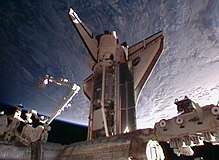
An example of technical risk analysis for a STS mission is SPRA iteration 3.1 top risk contributors for STS-133:[24][25]
- Micro-Meteoroid Orbital Debris (MMOD) strikes
- RS-25-induced or RS-25 catastrophic failure
- Ascent debris strikes to TPS leading to LOCV on orbit or entry
- Crew error during entry
- RSRM-induced RSRM catastrophic failure (RSRM are the rocket motors of the SRBs)
- COPV failure (COPV are tanks inside the orbiter that hold gas at high pressure)
An internal NASA risk assessment study (conducted by the Shuttle Program Safety and Mission Assurance Office at Johnson Space Center) released in late 2010 or early 2011 concluded that the agency had seriously underestimated the level of risk involved in operating the Shuttle. The report assessed that there was a 1 in 9 chance of a catastrophic disaster during the first nine flights of the Shuttle but that safety improvements had later improved the risk ratio to 1 in 90.[26]
Retrospect
While the system was developed within the original cost and time estimates given to President Richard M. Nixon in 1971, the operational costs, flight rate, payload capacity, and reliability by the time of the February 2003 Columbia accident proved to be much worse than originally anticipated.[27] A year before STS-1's April 1981 launch, The Washington Monthly accurately forecast many of the Shuttle's issues, including an overambitious launch schedule and the consequently higher-than-expected marginal cost per flight; the risks of depending on the Shuttle for all payloads, civilian and military; the lack of a survivable abort scenario if a Solid Rocket Booster were to fail; and the fragility of the Shuttle's thermal protection system.[28][29]
In order to get the Shuttle approved, NASA over-promised its economies and utility. To justify its very large fixed operational program cost, NASA initially forced all domestic, internal, and Department of Defense payloads to the shuttle. When that proved impossible (after the Challenger disaster), NASA used the International Space Station (ISS) as a justification for the shuttle.[30] NASA administrator Michael D. Griffin argued in a 2007 paper that the Saturn program, if continued, could have provided six manned launches per year – two of them to the Moon – at the same cost as the Shuttle program, with an additional ability to loft infrastructure for further missions:
If we had done all this, we would be on Mars today, not writing about it as a subject for "the next 50 years." We would have decades of experience operating long-duration space systems in Earth orbit, and similar decades of experience in exploring and learning to utilize the Moon.[31]
Some had argued that the Shuttle program was flawed.[32] Achieving a reusable vehicle with early 1970s technology forced design decisions that compromised operational reliability and safety. Reusable main engines were made a priority. This necessitated that they not burn up upon atmospheric reentry, which in turn made mounting them on the orbiter itself (the one part of the Shuttle system where reuse was paramount) a seemingly logical decision. However, this had the following consequences:
- a more expensive "clean sheet" engine design was needed, using more expensive materials, as opposed to existing and proven off-the-shelf alternatives (such as the Saturn V mains);
- increased ongoing maintenance costs related to keeping the reusable SSMEs in flying condition after each launch, costs which in total may have exceeded that of building disposable main engines for each launch.
A concern expressed by the 1990 Augustine Commission was that "the civil space program is overly dependent upon the Space Shuttle for access to space." The committee pointed out, "that it was, for example, inappropriate in the case of Challenger to risk the lives of seven astronauts and nearly one-fourth of NASA's launch assets to place in orbit a communications satellite."[33]
There are some NASA spin-off technologies related to the Space Shuttle program which have been successfully developed into commercial products, such as using heat-resistant materials developed to protect the Shuttle on reentry in suits for municipal and aircraft rescue firefighters.[34]
See also
References
- Cegłowski, Maciej (2005-08-03). "A Rocket To Nowhere". Idle Words. Retrieved 2008-09-26.
- "Space Transportation Costs: Trends in Price Per Pound to Orbit 1990–2000" (PDF). Futron. September 6, 2002. Archived from the original (PDF) on July 11, 2011. Retrieved 2010-12-28.
- "NASA – Space Shuttle and International Space Station". Nasa.gov. Retrieved 2010-08-07.
- "ILS May Pitch Proton as Cost-saver Over Soyuz for Galileo Satellites". 2010-01-16.
- The Rise and Fall of the Space Shuttle, Book Review: Final Countdown: NASA and the End of the Space Shuttle Program by Pat Duggins, American Scientist, 2008, Vol. 96, No. 5, p. 32.
- "Space Shuttle history - Shuttle operations". Century of Flight. Retrieved 2011-04-30.
- Axelrod, Alan (2008). Profiles in Folly: History's Worst Decisions and Why They Went Wrong. Sterling Publishing Company. pp. 62–63. ISBN 978-1-4027-4768-7.
- Handberg, Roger (2003). Reinventing NASA: Human Spaceflight, Bureaucracy, and Politics. Greenwood Publishing Group. ISBN 978-0-275-97002-4.
- Launius, Roger D.; Howard E. McCurdy (1997). Spaceflight and the Myth of Presidential Leadership: and the myth of presidential leadership. University of Illinois Press. pp. 146–55. ISBN 978-0-252-06632-0.
- "Space Transportation System". NASA KSC.
- "The Space Shuttle and Space Stations". The K–8 Aeronautics Internet Textbook. 1997-09-06. Retrieved 2008-09-26.
- "Critics scrutinize cost of shuttle". USA Today. 2003-02-04. Retrieved 2008-09-26.
- Lardas, Mark; Ian Palmer (2004). Space Shuttle Launch System 1972–2004: System 1975–2004. Osprey Publishing. p. 7. ISBN 978-1-84176-691-1.
- "Space Shuttle". The Internet Encyclopedia of Science. Retrieved 2008-09-26.
- Wade, Mark (1997–2008). "Shuttle". Retrieved 2010-05-24.
- Van Pelt, Michael (2005). Space tourism: adventures in Earth's orbit and beyond. Springer. pp. 75–76. ISBN 978-0-387-40213-0.
- "Columbia accident investigation board, public hearing". NASA. 23 April 2003. Archived from the original on 2006-08-12. Retrieved 2006-08-06.
- Vaughan, Diane (1996). The Challenger Launch Decision: Risky Technology, Culture, and Deviance at NASA. University of Chicago Press. ISBN 978-0-226-85175-4.
- Feynman, Richard. "Personal observations on the reliability of the Shuttle". Rogers Commission Report. NASA. Retrieved 6 August 2009.
- "Chapter 8: What Are Some Of The Rockets Used To Place Satellites In Orbit?". Visual Satellite Observing. Visual Satellite Observer's Home Page. February 1998. Retrieved 16 July 2010.
- "Upper Stages". U.S. Centennial of Flight Commission. Archived from the original on 27 May 2010. Retrieved 16 July 2010.
- "Columbia Accident Investigation Board Report". Archived from the original on 2007-09-16.
- "STS-1 In Flight Anomaly List" (PDF). 2003-02-27.
- Chris Gebhardt. "NASA Reviews COPV Reliability Concerns for Final Program Flights". NASASpaceflight.com. Retrieved December 14, 2010.
- Hamlin, et al. 2009 Space Shuttle Probabilistic Risk Assessment Overview (.pdf). NASA.
- Florida Today, "Report says NASA underestimated Shuttle dangers", Military Times, February 13, 2011. Retrieved February 15, 2011.
- "Columbia Accident Investigation Board public hearing". NASA – Columbia Accident Investigation Board. 2003-04-23. Archived from the original on 2008-10-16. Retrieved 2008-09-26.
- Easterbrook, Gregg (April 1980). "Beam Me Out Of This Death Trap, Scotty". The Washington Monthly. Archived from the original on 2003-02-03. Retrieved 15 September 2016.
- Day, Dwayne Allen (2011-06-27). "Gazing back through the crystal ball". The Space Review. Retrieved June 27, 2011.
- Krauss, Lawrence (2011-07-21). "The space shuttle programme has been a multi-billion-dollar failure". The Guardian. Retrieved 2013-08-19.
- "Human Space Exploration:The Next 50 Years". Aviation Week. 2007-03-14. Retrieved 2009-06-18.
- Watson, Traci (2005-09-30). "NASA administrator says space shuttle was a mistake". USA Today. Retrieved 2008-09-26.
- "Report of the Advisory Committee On the Future of the U.S. Space Program, Executive Summary". NASA. December 1990.
- NASA (1978). Spinoff (PDF). Washington, DC: U.S. Government Printing Office.
